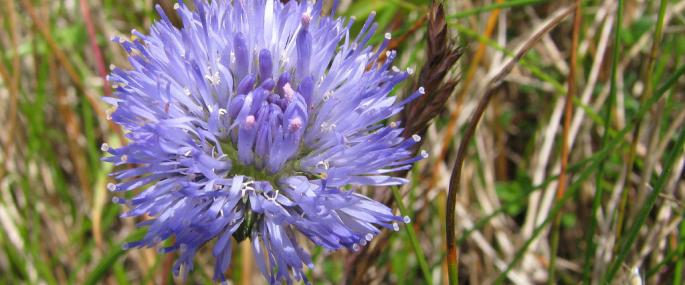Groundsel
Groundsel is an annual weed of cultivated or disturbed ground, popping up along field edges, roadside verges and on waste grounds. Branched stems lead to open clusters of yellow flowers that can be seen most of the year, and turn to white, fluffy seedheads. It is these seedheads that led to its Latin name, Senecio, derived from the word for 'old man' - pull the white fluffy seeds from the flower head and they leave behind a bare, dotted 'scalp'.
Some of our most abundant species are often treated as 'weeds' when they appear in the garden. Yet they can be extremely beneficial to wildlife, providing food for nectar-loving insects and shelter for minibeasts. Try leaving wilder areas in your garden and see who comes to visit... To find out more about wildlife-friendly gardening, visit our Wild About Gardens website: a joint initiative with the RHS, there's plenty of facts and tips to get you started.
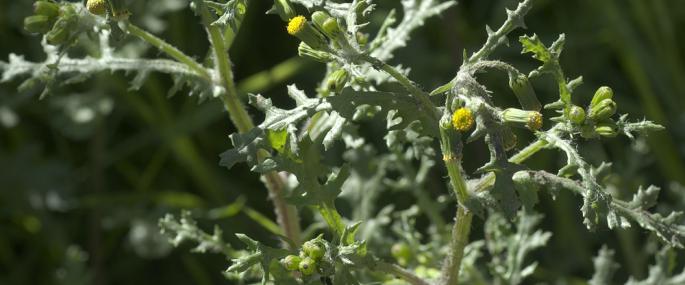
Ragwort
The daisy-like, yellow flower heads of Common Ragwort may be pretty enough to the casual observer, but they belie the poisonous nature of this plant. Renowned as a weed of paddocks and pastures where it can be harmful to livestock, it is not usually such an issue in gardens or waste grounds. In fact, it is the foodplant of the black and red Cinnabar Moth: sometimes its black- and yellow-barred caterpillars cover the plant, totally stripping the leaves. Common Ragwort flowers from June to November.
Many of our so-called 'weeds' are beneficial to wildlife, providing food for nectar-loving insects and shelter for minibeasts. Try leaving wilder areas in your garden, such as patches of Common Ragwort and longer grasses in your lawn and Stinging Nettles near the compost heap, and see who comes to visit... To find out more about wildlife-friendly gardening, visit our Wild About Gardens website: a joint initiative with the RHS, there's plenty of facts and tips to get you started.
Teasel
Teasels are probably most commonly known for their brown, prickly stems and conical seed heads which persist long after the plants themselves have died back for the winter. Between July and August, when Teasels are in flower, the spikey flower heads are mostly green with rings of purple flowers. Found in damp grassland and field edges, or on disturbed ground, such as roadside verges and waste grounds, Teasels are visited by bees when in flower, and birds when seeding.
Like many of our native plants, the Teasel is an excellent source of summer nectar and pollen for insects and autumn seeds for birds. To encourage wildlife into your garden, try planting native flower species in your borders to provide a 'nectar-cafe'. To find out more about wildlife-friendly gardening, visit our Wild About Gardens website: a joint initiative with the RHS, there's plenty of facts and tips to get you started.
Devil's-bit Scabious
The rounded and nodding, purple-blue flower heads of Devil's-bit Scabious can be found in damp meadows and marshes, and along woodland rides and riverbanks. It is in bloom between July and October, its pincushion-like flower heads attracting a wide variety of butterflies and bees. It is also the foodplant for the declining Marsh Fritillary Butterfly which is classified as a Priority Species in the UK Biodiversity Action Plan.
Our native wildflowers, such as Devil's-bit Scabious, provide important links in the food chain for many other animals, including rare species like the Marsh Fritillary Butterfly. The Wildlife Trusts recognise the importance of healthy habitats to support all kinds of species throughout the food chain, so look after many nature reserves for the benefit of wildlife. You can help too: volunteer for your local Wildlife Trust and you could be involved in everything from coppicing to craft-making, stockwatching to surveying.
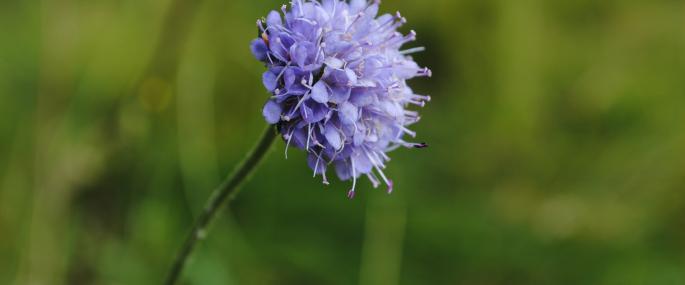
Red Valerian
The dense clusters of deep pink, almost crimson flowers, of Red Valerian are unmistakeable as they grow out on tall stems from old stone walls, roadside verges, railway cuttings, cliffs and rocks. Introduced into gardens before the 1600s, this plant from the Mediterranean soon escaped and became naturalised in the wild. Despite its non-native status, it is a good source of nectar for bees, butterflies and moths like the Hummingbird Hawk-moth.
Red Valerian is an introduced species that has become widespread and naturalised in the UK over hundreds of years without much cause for concern. However, the effects of introduced species are not always as benign. The Wildlife Trusts work with researchers, scientists and other conservationists to monitor changes in our native wildlife to determine the effects of environmental change, such as the introduction of new species or climate change. You can help: volunteer for your local Trust and you'll be able to monitor populations and survey habitats, adding to a growing bank of data.

Honeysuckle
The sweet, heady scent of Honeysuckle, carried on a warm summer breeze, is one of the most delightful experiences of the season. Strongest at night in order to attract pollinating moths, this scent is a happy addition to any garden. Honeysuckle is a climbing plant, common in hedgerows, scrub and woodlands where it twines itself around other shrubs and trees. Whorls of trumpet-shaped flowers appear from June to August and clusters of red berries ripen in the autumn.
Like many of our native plants, Honeysuckle is an excellent source of nectar and pollen for all kinds of insects and provides shelter and nesting spots for birds and small mammals. To encourage wildlife into your garden, try planting native flower species in your borders and climbers in your hedges and along your fences to provide a 'nectar-cafe'. To find out more about wildlife-friendly gardening, visit our Wild About Gardens website: a joint initiative with the RHS, there's plenty of facts and tips to get you started.

Cleavers
Cleavers is familiar to many of us as the bristly plant that easily hooks on to our clothing as we walk through the countryside or do the gardening. Children delight in its sticky nature, frequently attaching the angular stems to each other or even their pets. For this reason, it has many other common names such as 'Sticky Bobs', 'Stick-a-back' and 'Kisses' (because lovers cling to each other too). Cleavers is a climbing plant, using its hooks to aid its scrambling progress; the hooks on its fruits attach to animals and help to disperse its seeds.
Some of our most abundant species are often treated as 'weeds' when they appear in the garden. Yet they can be extremely beneficial to wildlife, providing food for nectar-loving insects and shelter for minibeasts. Try leaving wilder areas in your garden and see who comes to visit... To find out more about wildlife-friendly gardening, visit our Wild About Gardens website: a joint initiative with the RHS, there's plenty of facts and tips to get you started.
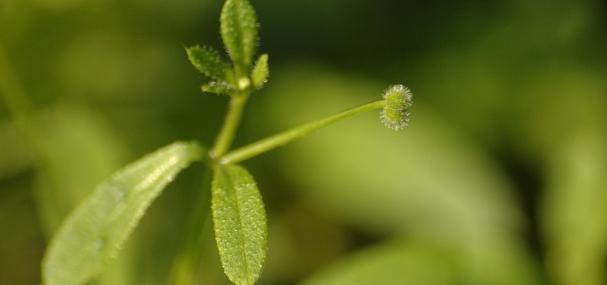
Lady's Bedstraw
The frothy, yellow flowers of Lady's Bedstraw scent the air of our grasslands, chalk downlands, meadows, heaths and sand dunes with honey. The stems can be so dense with flowers that they carpet the grass with yellow from June to September. Dried, this flower has the scent of new-mown hay, and its name is probably derived from the tradition of stuffing straw mattresses with it, particularly those of women about to give birth.
The Wildlife Trusts manage many grassland habitats for the benefit of all kinds of wildlife. Careful grazing with traditional breeds, hay-cutting at the right time and scrub clearance are just some of the ways these fragile habitats are kept in good condition - supporting wildflowers, such as Lady's Bedstraw, and, in turn, invertebrates and the larger animals that prey on them. By volunteering for your local Trust you can help too, and you'll make new friends and learn new skills along the way.
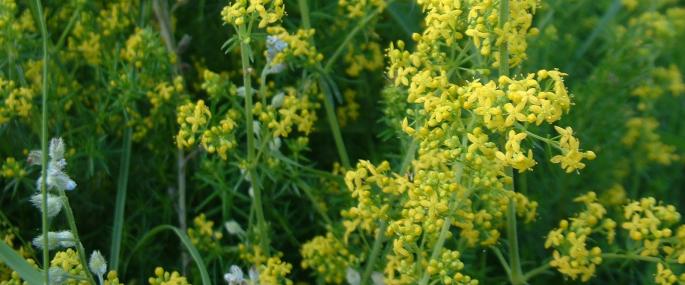
Crosswort
The small, pale yellow flowers of Crosswort can be seen in grassy woodland rides, hedgerows and roadside verges between April and June. They appear up the length of the stem along with the distinctive whorls of four leaves that give this plant its name. It prefers chalky or neutral soils and spreads using rhizomes (stems).
The Wildlife Trusts manage many grassland habitats for the benefit of all kinds of wildlife. Careful grazing with traditional breeds, hay-cutting at the right time and scrub clearance are just some of the ways these fragile habitats are kept in good condition - supporting wildflowers and, in turn, invertebrates and the larger animals that prey on them. By volunteering for your local Trust you can help too, and you'll make new friends and learn new skills along the way.
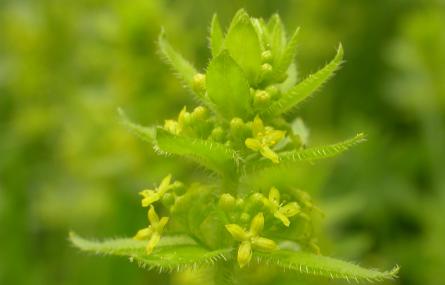
Sheep's-bit
The rounded, blue flower heads of Sheep's-bit can be found in dry, grassy places such as heaths, grasslands and cliff tops. Most common near the sea, it can often be seen growing in large numbers, carpeting the ground with its fluffy-looking flower heads from May to September. Sheep's-bit is a popular garden plant, especially for areas like rockeries, wild gardens and even old sinks - anywhere there is sandy, free-draining soil and plenty of sun.
Like many of our native plants, Sheep's-bit is an excellent source of nectar and pollen for all kinds of insects including bumblebees and butterflies. To encourage wildlife into your garden, try planting native flower species in your borders to provide a 'nectar-cafe'. To find out more about wildlife-friendly gardening, visit our Wild About Gardens website: a joint initiative with the RHS, there's plenty of facts and tips to get you started.
